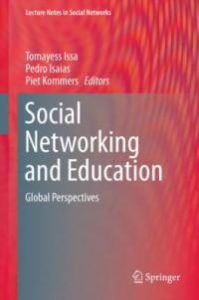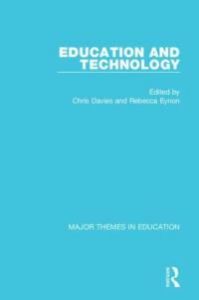Curious about the latest developments in education technology for the classroom? OISE Library has new books that you may find of interest, whether you are a student or instructor.
The Social Networking and Education: Global Perspectives (2016) series investigates the new Social Networking (SN) revolution in education. Social Networking is presented as having many uses in online instruction that can complement on-site classroom  instruction. This book will be of particular interest to educators and students in the Curriculum, Teaching & Learning, and Leadership, Higher & Adult Education programs. Articles present various methodologies for using social networking to communicate and collaborate. The articles contain tools and techniques intended for both students and educators. Contributors present critical perspectives from regions across the world about the risks and effects of social networking in education environments. This series is suited for academics and researchers, companies, and organizations. The Social Networking and Education Model (SNEM) offers an approach to applying social networking to education.
instruction. This book will be of particular interest to educators and students in the Curriculum, Teaching & Learning, and Leadership, Higher & Adult Education programs. Articles present various methodologies for using social networking to communicate and collaborate. The articles contain tools and techniques intended for both students and educators. Contributors present critical perspectives from regions across the world about the risks and effects of social networking in education environments. This series is suited for academics and researchers, companies, and organizations. The Social Networking and Education Model (SNEM) offers an approach to applying social networking to education.
Teaching the Last Backpack Generation: a Mobile Technology Handbook for Secondary Educators (2016) addresses current movements towards applying mobile technologies to teaching and learning in the classroom. The authors have backgrounds in the areas of education technology and special education applied to all levels of education, from primary to post-secondary. This book is ideal for students and instructors from the Curriculum, Teaching & Learning, and Leadership, Higher & Adult Education programs  who would like to apply technology strategies in the classroom, or develop strategies for themselves to learn about current uses of technology. The authors provide educators, administrators, and technology supporters with an extensive overview about integrating mobile technology in the classroom. Strategies sheets include steps for educators to identify and implement activities that are tailored to specific content areas and classroom settings. Lesson-planning worksheets will assist readers to develop and deliver lesson plans that integrate mobile technology. Readers will learn how to leverage current mobile technologies to engage students in a variety of learning environments.
who would like to apply technology strategies in the classroom, or develop strategies for themselves to learn about current uses of technology. The authors provide educators, administrators, and technology supporters with an extensive overview about integrating mobile technology in the classroom. Strategies sheets include steps for educators to identify and implement activities that are tailored to specific content areas and classroom settings. Lesson-planning worksheets will assist readers to develop and deliver lesson plans that integrate mobile technology. Readers will learn how to leverage current mobile technologies to engage students in a variety of learning environments.
Emerging Tools and Applications of Virtual Reality in Education (2016) describes recent advances in virtual reality for use as a tool to facilitate communication and interaction among educators and students. This book is comprised of thirteen chapters written by authors from several countries, working in academia and other disciplines. Chapters are  organized into three sections. The first section provides an overview of virtual reality and includes its developments and uses in K-12 and post-secondary education. The second section investigates the use of virtual reality in an education context, and explores various virtual reality tools, practices, and technologies. The third section considers critical issues and potential uses for virtual reality. Various applications for the use of virtual technology in a number of settings are explored, and will benefit students, educators, and administrators interested in learning how to integrate virtual reality into their activities.
organized into three sections. The first section provides an overview of virtual reality and includes its developments and uses in K-12 and post-secondary education. The second section investigates the use of virtual reality in an education context, and explores various virtual reality tools, practices, and technologies. The third section considers critical issues and potential uses for virtual reality. Various applications for the use of virtual technology in a number of settings are explored, and will benefit students, educators, and administrators interested in learning how to integrate virtual reality into their activities.
Bring Your Own Device: Engaging Students & Transforming Instruction (2016) provides readers with a framework and education initiatives that integrate the use of handheld devices in the classroom. This book will be of particular interest to students in the  Curriculum, Teaching & Learning program who plan to work as K–12 educators and administrators. The author, Kipp D. Rogers, a leader in educational technology, outlines steps to plan and develop Bring Your Own Device (BYOD), and how to integrate this model into teaching, learning, and assessment. Techniques for monitoring and evaluating the culture of BYOD in schools are also provided. The book includes an extensive list of current online resources to assist readers with developing BYOD initiatives that are suited to the needs of their educational settings.
Curriculum, Teaching & Learning program who plan to work as K–12 educators and administrators. The author, Kipp D. Rogers, a leader in educational technology, outlines steps to plan and develop Bring Your Own Device (BYOD), and how to integrate this model into teaching, learning, and assessment. Techniques for monitoring and evaluating the culture of BYOD in schools are also provided. The book includes an extensive list of current online resources to assist readers with developing BYOD initiatives that are suited to the needs of their educational settings.
The Education and Technology (2016) collection provides an impressive number of noteworthy writings on educational technology. As part of Routledge’s Major Themes in Education series, Education and Technology includes 83 writings in four volumes. Each  volume addresses key topics of the academic study of educational technology. The first volume covers foundations of educational technology theory and practice, and includes perspectives on learning and teaching. The second volume examines research about technology and learning sciences, and includes writings on designing technology for learning, and techniques for analyzing learning behaviour online. The writings in the third volume contextualize theory and practice in educational technology. The fourth and final volume in the collection features writings that address critical issues in the ongoing development of the field, and includes topics on digital divides and social inclusion, the rise of data and learning at scale, and perspectives on the future of educational technology.
volume addresses key topics of the academic study of educational technology. The first volume covers foundations of educational technology theory and practice, and includes perspectives on learning and teaching. The second volume examines research about technology and learning sciences, and includes writings on designing technology for learning, and techniques for analyzing learning behaviour online. The writings in the third volume contextualize theory and practice in educational technology. The fourth and final volume in the collection features writings that address critical issues in the ongoing development of the field, and includes topics on digital divides and social inclusion, the rise of data and learning at scale, and perspectives on the future of educational technology.
